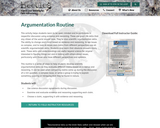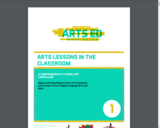
A research article with information on the differences between rubrics, checklists, and rating scales. It includes helpful tips for quality rubric design.

A research article with information on the differences between rubrics, checklists, and rating scales. It includes helpful tips for quality rubric design.

This activity helps students learn to be open-minded and to participate in respectful discussion using evidence and reasoning. These are great life skills that any citizen of the world should have. They’re also scientific argumentation skills. The ability to change one’s mind based on evidence and reasoning, to see issues as complex, and to look at issues and claims from different perspectives are all scientific argumentation skills. Students also learn that absolute answers rarely exist. These skills and understandings are useful beyond science for anyone interested in figuring things out and in talking with others about issues, particularly with those who have different perspectives and opinions.

Artists are often particularly keen observers and precise recorders of the physical conditions of the natural world. As a result, paintings can be good resources for learning about ecology. Teachers can use this lesson to examine with students the interrelationship of geography, natural resources, and climate and their effects on daily life. It also addresses the roles students can take in caring for the environment. Students will look at paintings that represent cool temperate, warm temperate, and tropical climates.
In this lesson students will: Identify natural resources found in particular geographic areas; Discuss ways in which climate, natural resources, and geography affect daily life; Apply critical-thinking skills to consider the various choices artists have made in their representations of the natural world; Make personal connections to the theme by discussing ways they can be environmental stewards; Identify natural resources found in particular geographic areas; Discuss ways in which climate, natural resources, and geography affect daily life; Apply critical-thinking skills to consider the various choices artists have made in their representations of the natural world; Make personal connections to the theme by discussing ways they can be environmental stewards.

This booklet about teaching through art education integrates topics such as peace, tolerance and interpersonal communication as well the treatment of psychological aspects in a post conflict environment through creativity and artistic language.

Anthropology is the study of all humans in all times in all places. But it is so much more than that. “Anthropology requires strength, valor, and courage,” Nancy Scheper-Hughes noted. “Pierre Bourdieu called anthropology a combat sport, an extreme sport as well as a tough and rigorous discipline. … It teaches students not to be afraid of getting one’s hands dirty, to get down in the dirt, and to commit yourself, body and mind. Susan Sontag called anthropology a “heroic” profession.” What is the payoff for this heroic journey? You will find ideas that can carry you across rivers of doubt and over mountains of fear to find the the light and life of places forgotten. Real anthropology cannot be contained in a book. You have to go out and feel the world’s jagged edges, wipe its dust from your brow, and at times, leave your blood in its soil. In this unique book, Dr. Michael Wesch shares many of his own adventures of being an anthropologist and what the science of human beings can tell us about the art of being human. This special first draft edition is a loose framework for more and more complete future chapters and writings. It serves as a companion to anth101.com, a free and open resource for instructors of cultural anthropology.

These active process-oriented lessons focus on concepts of line direction and type, organic shape, 3-D form, real and implied texture, secondary color, and principles of composition. Literacy-infused lessons explore text direction/spacing, observation, description, and story elements through drawing, painting, collage, clay modeling and printmaking.
The K-6 lesson handbooks were originally produced for the Lake Washington School District with grants from 4culture and ArtsWA. Encourage your colleagues, other schools, and organizations to use these materials for non-commercial, educational purposes at no cost by downloading their own copy at: http://artsedwashington.org/portfolio-items/alic-2

A broad range of art is created using concepts of contour and line type, abstraction, color palette, 3-D form, and positive and negative space. Students make both realistic and abstract drawings, relief prints, paintings, and paper sculptures. Literacy-infused lessons include making sketch/journal entries, inventing clay characters and illustrating stories and poems in collage.
The K-6 lesson handbooks were originally produced for the Lake Washington School District with grants from 4culture and ArtsWA. Encourage your colleagues, other schools, and organizations to use these materials for non-commercial, educational purposes at no cost by downloading their own copy at: http://artsedwashington.org/portfolio-items/alic-2

Fundamental concepts and skills are applied in new ways. Line is used to invent characters in monotype prints and show figures in action within drawings and wire sculptures. Elements of scale, horizon, overlapping, shape and texture in painting and printmaking reference specific time and place for settings. Students also visualize and write in response to art.
The K-6 lesson handbooks were originally produced for the Lake Washington School District with grants from 4culture and ArtsWA. Encourage your colleagues, other schools, and organizations to use these materials for non-commercial, educational purposes at no cost by downloading their own copy at: http://artsedwashington.org/portfolio-items/alic-2

Building traditional skills in drawing and painting is emphasized through study of proportion, value, color mixing, and space. Principles of balance and unity in 2-D and 3-D are explored through constructing tactile collages and paper sculptures. In literacy infused lessons, students connect word choice, detail, narrative and figurative language with images.
The K-6 lesson handbooks were originally produced for the Lake Washington School District with grants from 4culture and ArtsWA. Encourage your colleagues, other schools, and organizations to use these materials for non-commercial, educational purposes at no cost by downloading their own copy at: http://artsedwashington.org/portfolio-items/alic-2

Skills are refined through making pen and ink drawings, watercolor paintings, and sculptures focusing on proportion, value, and scale. Translating words into pictures and pictures into words is investigated through depicting setting, combining shapes for meaning, using color for mood and responding to art. Students also create prints and then explain the printmaking procedure in writing.
\The K-6 lesson handbooks were originally produced for the Lake Washington School District with grants from 4culture and ArtsWA. Encourage your colleagues, other schools, and organizations to use these materials for non-commercial, educational purposes at no cost by downloading their own copy at: http://artsedwashington.org/portfolio-items/alic-2

This creative start introduces concepts of line variety, geometric shape, actual texture, primary color, and pattern through exploratory drawing, painting, collage, and stamping. In literacy infused lessons, students make decorative letters, identify word sequence, analyze visual clues, and develop pictures by linking words and images.
The K-6 lesson handbooks were originally produced for the Lake Washington School District with grants from 4culture and ArtsWA. Encourage your colleagues, other schools, and organizations to use these materials for non-commercial, educational purposes at no cost by downloading their own copy at: http://artsedwashington.org/portfolio-items/alic-2

Several assignments are used for this course, including writing lesson plans, writing a unit plan, creating supplemental items for the unit plan, and designing a classroom management plan. In my course, I assign two units with three lesson plans included in each unit. This is designed for Early Childhood, but it can be edited for secondary.

We know you have come to this tutorial because you are a serious writer who wants to write well — and correctly! You have probably heard the word plagiarism and would like to understand it better. You have come to the right place. In this tutorial, you’ll learn:
What plagiarism is
How to recognize seven different kinds of plagiarism
The correct way to use ‘open access’ materials
The consequences of plagiarism
How to avoid plagiarism by doing the following:
Citing sources correctly
Recognizing ‘common knowledge’
Writing good paraphrases
Writing good summaries
Taking careful notes

Purpose: The goal of this guide is to provide a clear overview of the topics of predatory journals and questionable conferences and advice on how to avoid them. This guide intentionally adopts a plain language approach to ensure it is accessible to readers with a variety English language proficiency levels. Methods: Electronic searches were conducted manually using Google and Google Scholar, along with a search of the University of Calgary library research databases. Search terms included predatory journals, predatory publisher, predatory conference, questionable conference and vanity conference. Three primary types of sources informed this report: (1) scholarly peer-reviewed articles; (2) reputable popular media such as established newspapers; and (3) grey literature such as blogs written by experts and scholars. Findings: Plain-language overviews of predatory publications and questionable conferences are provided to help researchers understand what these are and how to avoid them. A discussion of how to figure out where an aspiring author should publish their work is included, as well as a checklist for determining if a conference is worth the prospective presenter’s time and resources. Implications: There are implications for mentors of graduate students and early-career stage academics, as well as for institutions as a whole. The issue of questionable conferences and publications is so complex that early-stage academics require support and mentorship to cultivate a deeper understanding of how to share their work in a credible way. Additional materials: Contains 66 references and 2 tables.

Trace the legacy of Babylonian discoveries and ideas, including their mathematical system based on 60 and their desire to predict the future. With British Museum curator Irving Finkel. © Trustees of the British Museum. Created by British Museum.

Video lesson intended for grades 3-5 with a mindfulness moment, warmup, instruction and practice of basic balance and transfer of weight movements, and a sequence of two movements. Video is 15:48 minutes in length.Video created by Virginia's Chief Movement Officers cadre in collaboration with Focused Fitness, Virginia Department of Health, and Virginia Department of Education.

A computer is an automatic, electronic, data-processing machine that takes in facts and figures known as data, and then processes or organizes it in some useful way. Afterwards it outputs, or displays, the results for you to see as information. Keep in mind that data is not information. Rather, information is the knowledge that you, the end-user, derive from accurate data that are entered into a computer. Only after processing, is data transformed into information which is then used for decision making. (Almost) each part of a computer can be classified as either hardware or software.

Basic Kitchen and Food Service Management is one of a series of Culinary Arts open textbooks developed to support the training of students and apprentices in British Columbia’s foodservice and hospitality industry. Although created with the Professional Cook, Baker and Meatcutter programs in mind, these have been designed as a modular series, and therefore can be used to support a wide variety of programs that offer training in foodservice skills.

This training video is part of a series dedicated to helping child welfare workers learn practical skills to cope with the emotional tolls of their very important work. In this video, a meditation specialist goes over basic meditation practices that can be completed in or around the workplace with minimal interruption time.

Wrap your mind around the world, but without strawberries, watermelons, or chocolate. Humans rely on pollinators such as native bees, honey bees, butterflies, birds, and even flies for these and other important foods around the world. In our neighborhoods, pollinators are in trouble. This video link will support educators as they teach the Bee A Friend To Pollinators lesson plans, helping children become advocates for pollinator-friendly schools and community spaces.